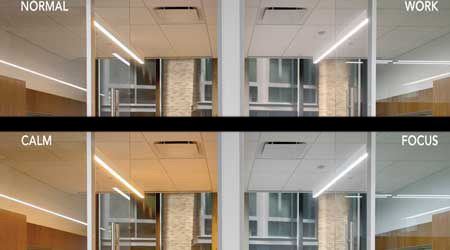 When Michael Best LLC relocated its Washington, D.C., office, the firm identified tunable-white lighting as a highly desirable office lighting feature. The system allowed occupants to select one of four presets in key spaces: “Focus” (5000K), “Work” (4200K), “Normal” (3500K), and “Calm” (2700K), supporting different uses of the spaces.
When Michael Best LLC relocated its Washington, D.C., office, the firm identified tunable-white lighting as a highly desirable office lighting feature. The system allowed occupants to select one of four presets in key spaces: “Focus” (5000K), “Work” (4200K), “Normal” (3500K), and “Calm” (2700K), supporting different uses of the spaces.Understanding Lighting Controls Protocols
Three main lighting controls protocols define how components operate and communicate.
For a control system to operate, all components must be designed to operate based on a common protocol, or otherwise possess the capability of operating under multiple protocols. These protocols allow components to communicate and also define how they operate. Facility managers have similar choices as with other control systems.
1. An analog wired dimming method, 0-10V is familiar and relatively low in initial cost. Ideally, there is one dimming input (dimmer or channel of a system) for intensity, another for color control. (Some early luminaires used one input to a driver controlling one group of LEDs at one CCT, and a second input to a control a second driver controlling a second group of LEDs at a different CCT. This method made it extremely difficult to achieve a specific desired intensity and CCT level, and is rarely used now). Communication of the control signal is one-way, with no data going back the other way for analyzing energy consumption, monitoring, etc. Performance isn’t standardized and therefore can vary, so it may be beneficial not to mix manufacturers in a space. Overall, 0-10V is suitable for low-precision dimming and color tuning where cost and familiarity are important factors, and where data retrieval isn’t necessary.
2. The Digital Addressable Lighting Interface (DALI) is an open standard, so performance is standardized and therefore predictable, allowing mixing and matching of products. The signal, however, can be slow with a few seconds of delay. Control wiring (DALI bus) can run between luminaires, sensors, and interfaces in any order. Tunable-white luminaires can be programmed using software or operated with multi-scene preset wallbox workstations or pairs of wallbox slider dimmers. Data retrieval is enabled. Overall, DALI is well-suited for installation as part of a larger networked control system, and where the time delay is acceptable.
3. DMX-512 is a theatrical protocol that is proving beneficial for commercial general lighting applications where a high degree of color control is desired. Response is nearly instant, with no time delay. Many DMX tunable-white luminaires can interface with an analog or DALI interface for fast response. Overall, DMX is well suited for custom, atypical, and responsive applications such as houses of worship and education.
Another family of interfaces communicate using wireless signals. Some receivers are able to operate on the signals from multiple standard protocols. This is well suited for applications with new luminaires or where installing wiring is difficult or costly. Common standard protocols include Bluetooth, WiFi, and ZigBee.
In addition to the above as standardized protocols, some manufacturers offer proprietary wired and wireless protocols that either optimize standard protocols or conceive them from scratch for optimization of their particular systems. This provides a single-source solution conceived, tested, and supported as a complete system, often eliminating the commissioning issues found in other protocols and offering better integration with other devices in the space. However this solution does require working with a single manufacturer to access the required components.
Related Topics:














